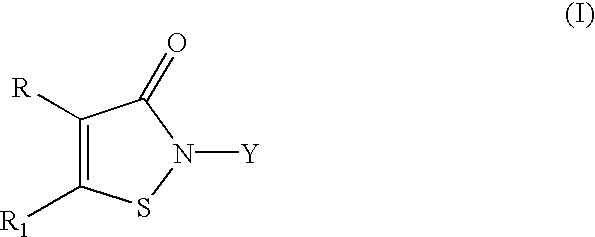Preservation of wood products
a wood product and preservative technology, applied in the field of wood material treatment, can solve the problems of high toxicity of chromium and arsenic salts, significant environmental hazards, and high toxicities of treated wood, so as to increase the penetration of iron salt/microbicidal agent, reduce treatment time, and increase the effect of preservative treatmen
- Summary
- Abstract
- Description
- Claims
- Application Information
AI Technical Summary
Benefits of technology
Problems solved by technology
Method used
Image
Examples
example 2
The weatherometer was a Carbon Arc Weatherometer (available from Atlas Co.) and exposure conditions included constant irradiation of 0.35 watts / square meter (W / m.sup.2) with a 20-minute water spray every 2 hours to introduce humidity (according to ASTM G-26, published by the American Society for Testing and Materials).
Wood surfaces were analyzed for lignin loss after exposure in the weatherometer using photoacoustic spectroscopy / Fourier transform infrared spectroscopy (PAS / FTIR) at a depth of 8, 50 and 75 microns (.mu.). A Bio-Rad FTS 6000 step-scan spectrometer (Cambridge, Mass., USA), equipped with a water-cooled ceramic mid-infrared source and a KBr crystal beamsplitter, was used with a helium-purged MTEC 300 photoacoustic detector (Ames, Iowa, USA). Data were collected using rapid-scan and step-scan phase modulation frequencies of 40 K, 20 K, 10 K, 2.5 K, 800, 400, 100 and 50 Hz at probing depths of 2.5-71.mu. at 1500-2000 cm.sup.-1. Circular sections (1 cm diameter) were cut fr...
PUM
| Property | Measurement | Unit |
|---|---|---|
| period of time | aaaaa | aaaaa |
| time | aaaaa | aaaaa |
| temperature | aaaaa | aaaaa |
Abstract
Description
Claims
Application Information
 Login to View More
Login to View More - R&D
- Intellectual Property
- Life Sciences
- Materials
- Tech Scout
- Unparalleled Data Quality
- Higher Quality Content
- 60% Fewer Hallucinations
Browse by: Latest US Patents, China's latest patents, Technical Efficacy Thesaurus, Application Domain, Technology Topic, Popular Technical Reports.
© 2025 PatSnap. All rights reserved.Legal|Privacy policy|Modern Slavery Act Transparency Statement|Sitemap|About US| Contact US: help@patsnap.com

